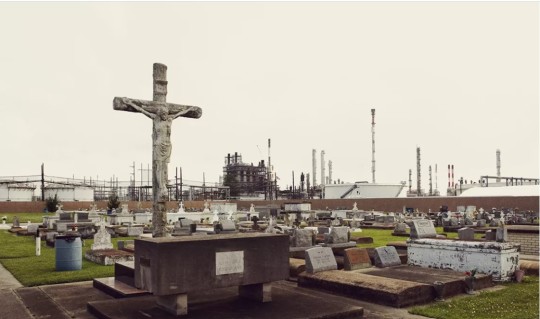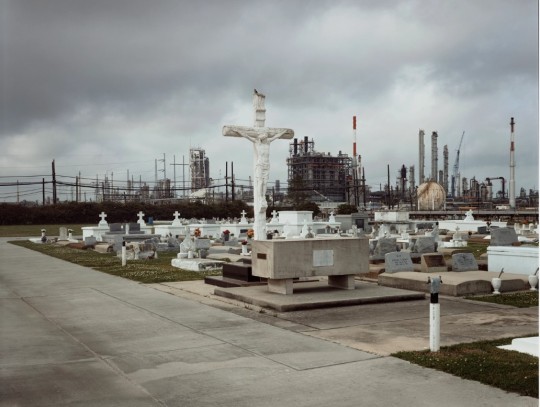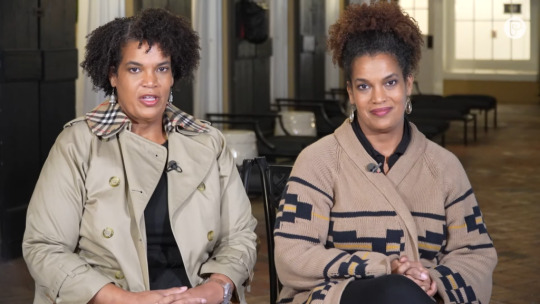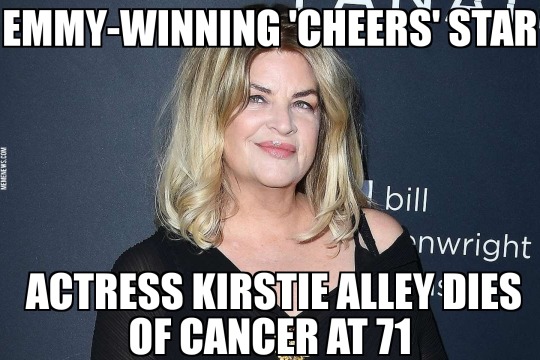#cancer alley
Text
"The Environmental Protection Agency (EPA) finalized a rule Tuesday [April 9, 2024] that will require 218 chemical plants to reduce toxic and carcinogenic airborne pollutants, aiming to reduce the number of people with elevated cancer risk by 96% nationwide.
The rulings principally address chloroprene: used to make rubber products, and ethylene oxide, used primarily for sterilizing medical supplies. Long-term exposure to these chemicals and their manufacturing have been identified as possible carcinogens, or cancer-causing agents.
According to a report in the Washington Post, this can include lymphoma, leukemia, breast cancer, and liver cancer.
Across a strip of Louisiana and Texas where half of the 218 chemical manufacturing facilities set to be affected by the new regulations are located, cancer rates of these kinds are substantially higher than national averages, leading it to be colloquially called “Cancer Alley.”
EPA Administrator Michael Regan visited Cancer Alley during the open-comment period of the proposed ruling, and said that across the 85 miles dotted with communities, he failed to meet a single person who didn’t know a loved one or friend who had either developed cancer, died of it, or knew someone who had.
Once implemented, the ruling will reduce more than 6,200 tons of toxic air pollution each year, according to the Post."
-via Good News Network, April 15, 2024
#I was going to say “wait isn't it normal for everyone to know someone who got cancer”#then I remembered that I grew up three miles from the site of a gigantic nuclear meltdown#which hardly anyone knows about it because they fucking covered it up btw#so it's possible I'm wrong and that is not a normal thing#united states#epa#environmental protection agency#louisiana#texas#cancer#cw cancer#public health#pollution#air pollution#environmental racism#environmental justice#oncology#good news#hope#cancer alley
311 notes
·
View notes
Text



collection of journalistic photos of Holy Rosary Cemetery in Taft, Louisiana, known as "Cancer Alley"
#op#louisiana#southern gothic#taft louisiana#cancer alley#holy rosary cemetery#catholic#crucifix#dystopian
830 notes
·
View notes
Text
youtube
The Devastating Toll of the Fossil Fuel Industry in Louisiana’s Cancer Alley
3 notes
·
View notes
Quote
Nurdles have a significant impact on the environment long before they are formed, as well. The vast majority of the plastics plants in the United States are located alongside communities of color, which are disproportionately impacted by industrial pollution. Those plants emit a toxic mixture of pollutants including ethylene oxide, styrene, and benzene; there are so many petrochemical plants located between Baton Rouge and New Orleans that the area has become known as “cancer alley.”
Neel Dhanesha, ‘The massive, unregulated source of plastic pollution you’ve probably never heard of’, Vox
#Vox#Neel Dhanesha#Nurdles#United States#plastics plants#communities of color#industrial pollution#ethylene oxide#styrene#benzene#petrochemical plants#Baton Rouge#New Orleans#cancer alley
9 notes
·
View notes
Link
Excerpt from this story from Grist:
Louisiana must examine how polluters imperil the health of Black residents, the Environmental Protection Agency said in a letter it sent last week to state regulators in response to civil rights complaints about air pollution in the region known as Cancer Alley.
Black residents in southeastern Louisiana bear a disproportionate cancer risk from industrial air pollution, the agency found, with children at one predominantly Black elementary school having been exposed to a dangerous carcinogen at levels 11 times what the EPA considers acceptable.
ProPublica reported last year that the EPA does a poor job of regulating the combined risk from multiple sources of industrial air pollution. In parts of Cancer Alley, ProPublica estimated lifetime cancer risk is up to 47 times what the EPA deems acceptable.
The EPA letter urged Louisiana’s environmental and health agencies to analyze cumulative impacts for residents near a synthetic rubber plant owned by Denka Performance Elastomer in St. John the Baptist Parish and a proposed Formosa plastics facility in St. James Parish.
“What’s remarkable is that EPA, for the first time in a long time, is speaking the truth around environmental racism and willing to put civil rights enforcement tools out there,” said Monique Harden, assistant director of law and public policy at the Deep South Center for Environmental Justice. Federal civil rights protections predate the EPA, but they haven’t been enforced, she said: “There’s nothing new to any of this except that we have leadership at the EPA” that “wants to do something about it.”
11 notes
·
View notes
Text
Minority Influence and the Coming #GOPDystopia
When the country is divided into thirds, everyone is a minority, and everyone is using minority influence. Learn what minority influence is, how the GOP has been using it against us, and how we can use it for us in the '22 election!
Is It Too Late To Avoid Civil War and Save Our Democracy?
We’re in the middle of the fight of our lives. The forces of the 1890’s are everywhere and moving against every gain we’ve made since then: taking away rights, the social safety net, and any regulation of business. If we’re not careful we will be living in Cancer Alley, drinking Flint water, paying for Texas utilities, and dying quickly…

View On WordPress
#GOPDystopia#Authoritarianism#Behavior Style#Cancer Alley#Dystopia#Flexibility and Compromise#Flint Water#Identity#Minority Influence#Minority-Rule#Pseudo-Democratic#Serge Moscovici#Single-Party#Style of Thinking#Texas Utilities
3 notes
·
View notes
Text
1 note
·
View note
Text
Growing up in Louisiana, on the West Bank of the Mississippi River, Jocyntia “Jo” Banner and her sister Joyceia “Joy” Banner learned about the 1811 revolt by enslaved people from their grandmother. Their matriarch said the heads of those who rebelled and fought for their freedom were cut off and put on stakes along the Mississippi River. The story, Banner said, had been passed down in her family from generation to generation through oral tradition, but it’s not just folklore.

The 1811 revolt began at the Woodland Plantation in LaPlace, Louisiana. Charles Deslondes and about 25 other enslaved people attacked Manuel Andry and his son, killing the son. As they marched toward New Orleans, enslaved people from other plantations joined them, with the crowd of rebels growing to more than 500. The group was stopped by the military and captured. Some were put on trial and executed.
“They were freedom fighters,” Jo Banner said of the 1811 revolt participants. “They were trying to save their lives and the lives of their family.”
And now the Banner sisters are working to save their history as the new owners of that plantation that was home to what has been described as the largest uprising of enslaved people in American history.
During the last few years, the Banners had been in talks with the owner of the Woodland Plantation, Timothy Sheehan, about the importance of preserving Black history in the River Parishes, Jo Banner said. In 2023, Sheehan contacted the Banner sisters and told them he planned to put the property up for sale and asked if they were interested in purchasing it.
According to records in the St. John the Baptist Parish Clerk of Court Office, the sisters, through their nonprofit, The Descendants Project, bought the plantation for $750,000 in January. The purchase included the 4,000-square-foot main building and four acres. The Banners founded The Descendants Project, to “preserve and protect the health, land, and lives of the Black descendant community located in Louisiana’s River Parishes.”
Recommended Stories
Sharlene Sinegal-DeCuir, an associate professor of history at Xavier University, said “it’s amazingly powerful” that generations after the 1811 revolt, the descendants of the enslaved have the “right to tell the stories of their generation, of their legacy.”
“It gives the lives of those who lived at that time justice for what they were doing,” Sinegal-DeCuir said. “It just turns Louisiana history on its head because now we are able to tell the story of resilience, of reliance in the community, of hope, of strength, of all those things that other narratives buried down.”
Sinegal-DeCuir said the 1811 revolt demonstrated that enslaved people were “not happy slaves on the master’s plantation.”
“We wanted more. We aspired for more, and we were going to fight for more,” she said. “They were willing to die for what they believed in because I think they had a greater understanding of how it would impact their descendants later on.”

Recently, The Descendants Project has been fighting to keep Greenfield Louisiana LLC, a grain elevator export company, from building a plant in the Louisiana River Parishes area already oversaturated with oil and chemical companies, giving the community the sobering moniker of Cancer Alley.
The industrial companies that populate Cancer Alley are along the same route that Deslondes and the rebels of the 1811 revolt took during their journey that started at the Woodland Plantation, which was added to the National Register of Historic Places in 2017.
“Knowing that home’s history and everything that happened, that our names are going to be put in the paperwork of this home, that you’re going to see it going all the way from the 1700s and white ownership and all of a sudden that they got more melanin on that title history, we’re already seeing how impactful that is for us to be in this space just as Black women,” Jo Banner said. “We’re going to provide access to the history in a way that Black people can feel welcome in the space.”
#Black twin sisters buy Woodland Plantation#site of the largest US uprising of enslaved people#Louisiana#woodland plantation#River Road Massacre#Cancer Alley#The Descendants Project#1811 Revolt#Charles Deslondes
1 note
·
View note
Text
Click on the link for a printable toolkit for how you can use Black Panther to fight racism, colonialism, etc.
Mitch has links to organizations and group discussion questions. It is printable and great for classroom use!

#fandom forward#black panther#wakanda forever#blm#black lives matter#activism#environmental activism#climate justice#racial justice#immigrants they get the job done#close the camps#families belong together#anti colonialism#immigration reform#cancer alley#standing rock#flint water crisis#bring back our girls#environmental racism#rip chadwick boseman#chadwick boseman#marvel#mcu#killmonger was right#anti facist#anti facism#anti imperialism#police abolition#fuck the police#acab
0 notes
Link
2 notes
·
View notes
Text
Vidal [...] emphasizes the close relationship that existed between the Louisiana settlement [at New Orleans] and the Caribbean island [Haiti, the colony of Saint-Domingue] during the former’s French colonial period (1718-69). It has become a bit of a popular adage to describe New Orleans as the northernmost port of the Caribbean, but Vidal’s Caribbean New Orleans: Empire, Race, and the Making of a Slave Society demonstrates the substance behind these claims. [...] New Orleans is the missing link, a late-forming city that largely inherited its founding ideas, practices, peoples, plants, and laws from its longer-established imperial neighbors [Spain, France, Britain, the United States]. It thus offers the ideal case study in which to consider how colonies around the Americas developed in conversation with one another [...].
Vidal convincingly argues that New Orleans was a “slave society,” or a settlement in which racialized slavery informed every part of everyday life from its inception, whose physical construction was done alongside the “construction of racial categories” (p. 1).
This is an important shift within Louisiana historiography, which has long stood by [...] [the] argument that early New Orleans offered the semi-unique example of a “slave society” devolving into a “society with slaves.” Abandoned by the French following the spectacular failure of the Compagnie des Indes, the standard story goes, New Orleans became an isolated backwater until the 1770s, struggling to survive and permitting, out of sheer need, less disciplined contact between residents of European, Indigenous, and African birth and descent. [But] Vidal, in contrast, shows that, while Louisiana struggled to create a full-fledged plantation economy during the French era, this did not prevent its capital from organizing itself along the highly stratified lines of the Caribbean islands.
---
Furthermore, she argues, because New Orleans did not see many new residents after 1731, free or enslaved, and because it was a smaller settlement, white inhabitants were able to build upon these ideas in a relatively stable environment - focusing much of their energies on surveilling, containing, and disciplining the enslaved and free persons of color (p. 26). [...]
Vidal especially points to the 1729 Natchez attack and ensuing Natchez Wars [against Indigenous peoples] as pivotal moments in the militarization of white New Orleanians [...]. Subsequently, a scrupulous supervision of racial boundaries became the norm for the rest of the French era and fostered “a sense of community among white urbanites” (p. 141).
Chapter 3 takes readers to the streets, levees, and other public spaces of New Orleans, where whites sought to sculpt the privileges of “whiteness” against both residents of African birth and descent as well as one another. Elite men and their wives scuffled over the best seating at church in an effort to recreate France’s ancien régime culture; socially lower soldiers and nonslaveholders, meanwhile, carefully guarded their weaker claims at mastery through street violence that frequently targeted the enslaved and free individuals of color. [...] Beginning with a careful reading of census categories, Vidal traces how distinctions between European settlers [...] were increasingly replaced with those centered exclusively on race by 1763. These efforts were paralleled by segregating practices in other domestic spaces. Close interactions, then, as Vidal forcefully shows, effectively strengthened, rather than weakened, urban racial hierarchies. [...] [Vidal then] follows the ways in which the demographically diverse workforce of the early colony made up of white indentured servants, convicts, and soldiers in addition to enslaved Africans - gave way to associations of difficult and degrading labor limitedly with the enslaved. [...]
---
French Louisiana inherited racial categories from the Caribbean but adjusted them to fit local needs, experiencing “not so much a loosening, but a more complex transformation” of its racial regime, largely through violence (p. 371).
Vidal documents how the Superior Council utilized targeted prosecutions and punishments to increasingly “imprint terror and instill obedience” on the enslaved (p. 390). [...] [The book] thus details a society in which racial hierarchies were asserted and supported through both top-down and bottom-up policies and practices, as “no social institution or relationship was left untouched by race” (p. 504).
To this end, Vidal speaks to important conversations by historians of enslaved women in the British Caribbean, including Jennifer Morgan and Marissa Fuentes. These authors have used a similarly wide range of sources [...] [and] archives to underscore the invasive nature of colonial racism. [...] [I]n part [...] Vidal’s [chapters work] to decouple lower Louisiana history from the fur traders of New France [Ontario/Quebec, and the watersheds of the Mississippi/Missouri rivers] and to reattach it to the planters of Saint-Domingue [in Haiti and the Caribbean]. [...] Combing through administrative papers, censuses, laws, parish registers, correspondence, and judicial records from both sides of the Atlantic, readers will get a sense that there is little Cécile Vidal has not seen or considered. [...] Her book will prove essential reading [...] and it hopefully will convince an even wider audience [...] [to engage with] comparative, cis-Atlantic, and transatlantic studies of imperialism, race, and slavery.
---
All text above by: Kristin C. Lee. "Review of Vidal, Cécile, Caribbean New Orleans: Empire, Race, and the Making of a Slave Society". H-Atlantic, H-Net Reviews. January 2022. [Bold emphasis and some paragraph breaks/contractions added by me.]
#tho american louisiana 1805ish to 1865 was obviously brutal slave society and an epicenter of US slavery vidals book makes case that#earlier french new orleans also fundamentally slave society in own distinct ways despite citys reputation as relatively cosmopolitan#and today louisiana now home to cancer alley pollution y fossil fuel pipelines y industrial chemical refineries y prisons built on plantati#300 years of violent racial hierarchy in louisiana wearing different masks#her footnotes are extensive y detailed enough to be a whole other book quite the synthesis
17 notes
·
View notes
Text
everything is too expensive & urgent & i would love love LOVE to have a few days of things going WELL.
#on an unrelated note. i will never go into law & certainly not US law. HOWEVER.#american environmental laws that concern (a) corporate personhood -> first amendment -> climate denialism (i.e. the right to lie)#and (b) environmental personhood (species or body of water or territory is an indigenous Person) + human harm/toxicity caused by pollutants#(so like. Wild Rice as person but also Human Person from louisiana's cancer alley)#-> and associated corporate responsibility for harm & state responsibility for protection cases#are all. SOOOOO INTERESTINGGGGG#about to get a fucking j.d. just to learn exhaustively about ALL OF IT#people who become so infuriated by [x] injustice that they go into law: i understand you SOOOOO WELL
6 notes
·
View notes
Text
The Haudenosaunee (Iroquois Confederation)'s Law of Peace and Seventh Generation Principle Can Save our Democracy and Climate
The Haudenosaunee taught the Founding Fathers about functional successful democracy, and they can teach us the same lessons again. And, brother do we need them if we are going to save ourselves from the GOP Dystopia and the climate disaster.
SUMMARY: The Haudenosaunee have had an outsized influence on US history, and it is time for them to influence us again. They have used a consensus-based democracy for almost 1,000 years by following two principles that it would behoove us to start using: (1) EVERYONE in the country is committed to the principles of democracy and (2) we make our political and economic decisions based on…

View On WordPress
#5 Calls#52-Card Pickup#Cancer Alley#Climate Change#Democracy#Dystopia#Five Nights at Freddy&039;s#Flint Water#Florida Education#Founding Fathers#Go-Fund-Me Healthcare#GOP Dystopia#Haudenosaunee#I2I4#Indivisible#Iroquois Confederation#Mad Max#Minority-Rule#Oligarchy#Pseudo-Democratic#Single-Party#Sustainability#Sylent Green#Texas Utilities#The Great Law of Peace#The Seventh Generation principle
0 notes
Text
Kirstie Alley dies

View On WordPress
5 notes
·
View notes
